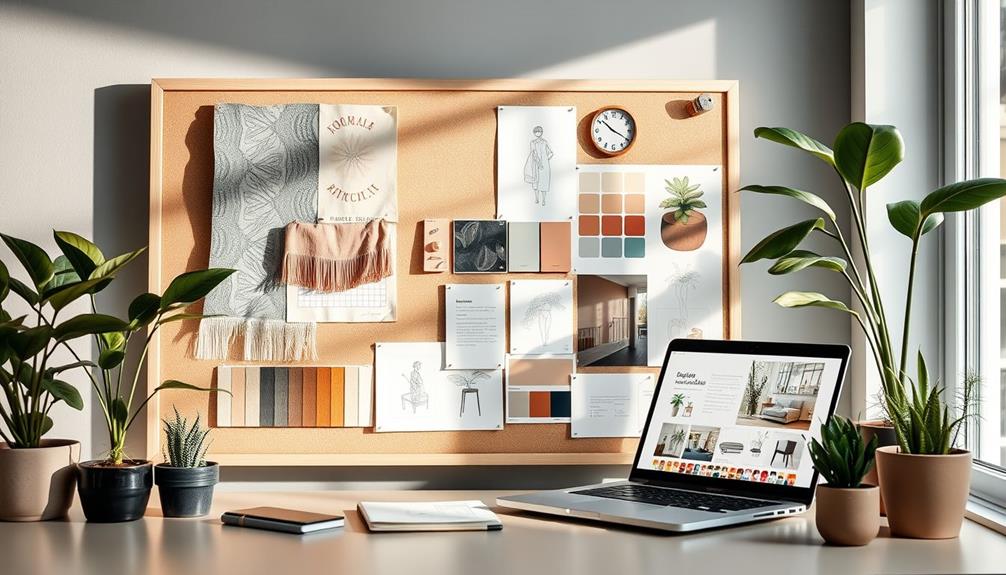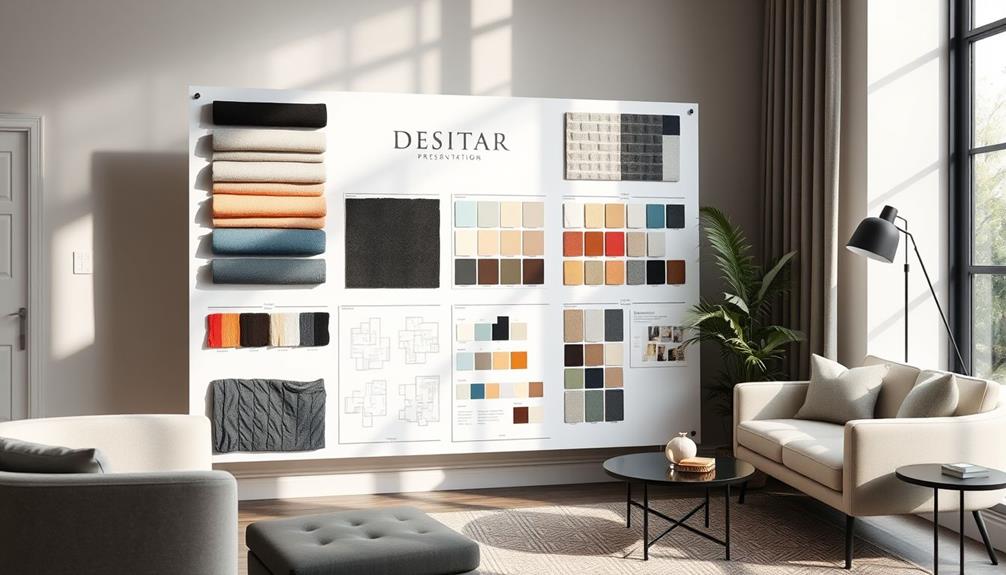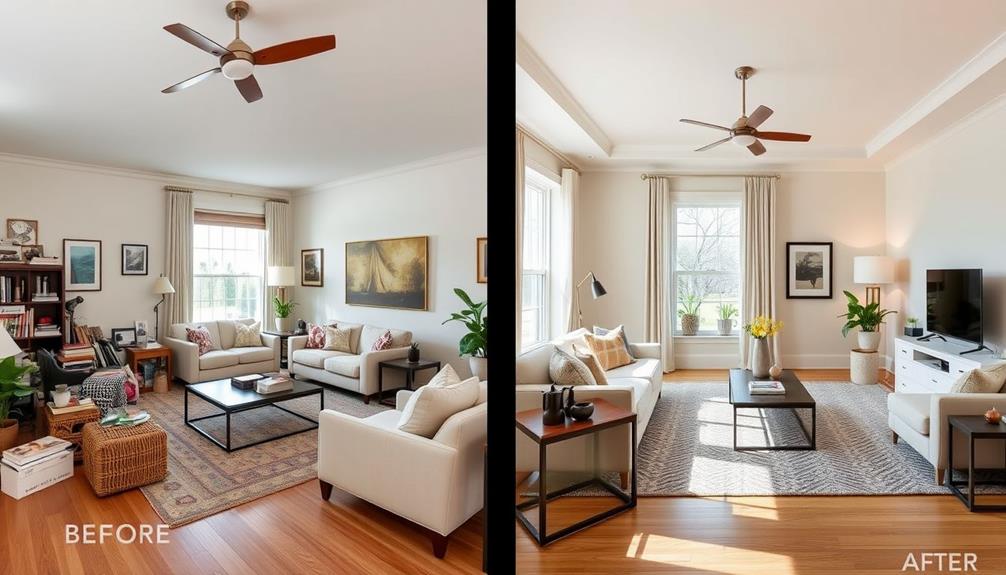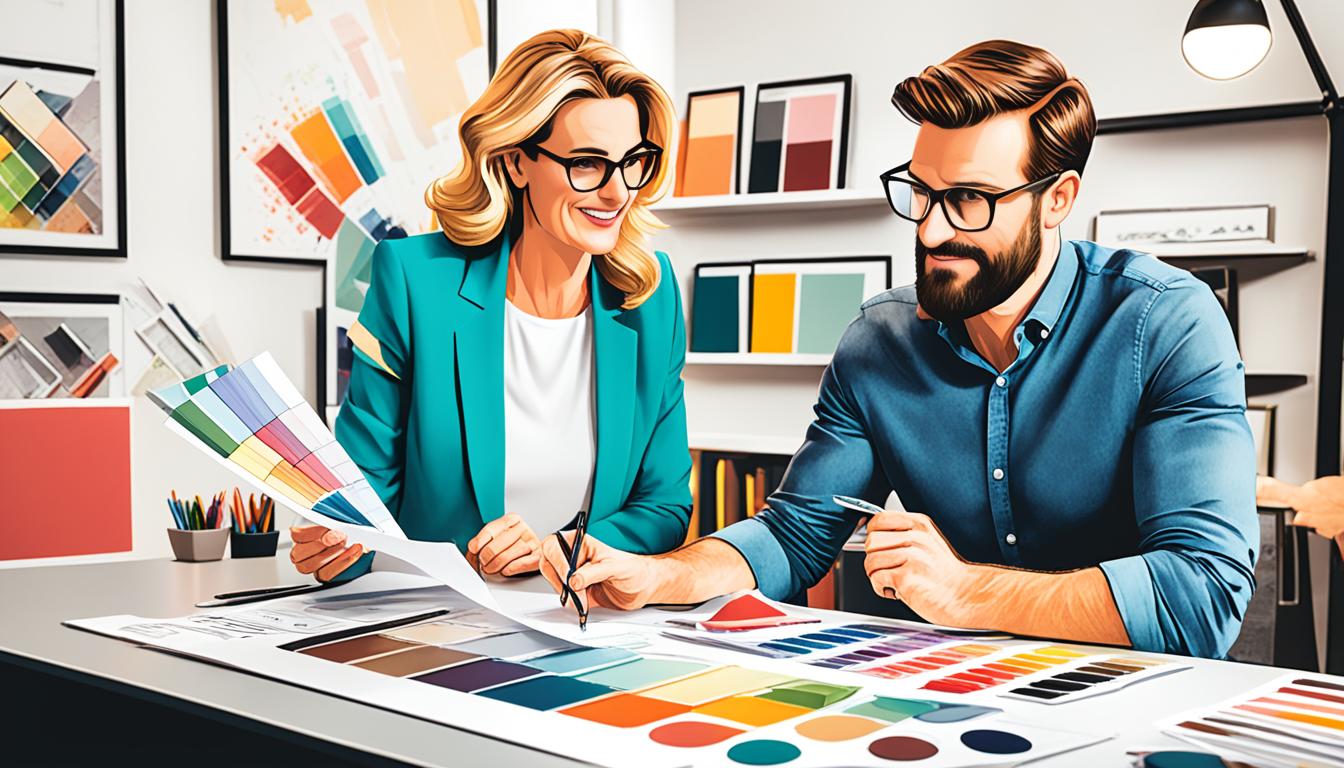To present your interior design ideas effectively, focus on visual tools that enhance client engagement. Start with mood boards to create a visual narrative, showcasing color palettes, textures, and themes. Incorporate software like Photoshop and AutoCAD for stunning visuals and clear layouts. Make sure to schedule presentations at key milestones for client feedback. Personalize the experience by reflecting your clients' styles and preferences. Remember to maintain transparency about costs and listen to their input throughout the process. Want to elevate your presentations even further? There's more to explore for making your designs stand out!
Key Takeaways
- Create mood boards to visually represent design concepts, incorporating color palettes, textures, and materials to enhance client engagement.
- Utilize software tools like Photoshop and AutoCAD for stunning visuals and realistic renderings that elevate presentation quality.
- Schedule presentations at key milestones to facilitate client feedback and open communication, ensuring alignment with their vision.
- Incorporate storytelling techniques to help clients envision lifestyle enhancements and emotional connections to design proposals.
- Provide a clear budget breakdown with itemized costs and visual aids to ensure transparency and manage client expectations effectively.
Understanding Design Tools

When you immerse yourself in interior design, understanding the right tools can make all the difference. One vital tool is the mood board, which visually represents your design concepts and themes. Mood boards help your clients grasp the overall aesthetic before you engage in implementation. They facilitate clearer communication, guaranteeing everyone's on the same page throughout the design process.
Beyond mood boards, utilizing software like Photoshop or InDesign can elevate your presentations to a professional level. These tools allow you to create stunning visuals, incorporating fabric swatches and paint samples that clients love. By leveraging digital resources, you can showcase your design concepts in a way that captivates and engages your audience.
Additionally, tools like Cedreo can enhance your presentations by allowing you to create 3D floor plans and realistic renderings. This way, your clients can see exactly how their space will look, improving their understanding and satisfaction with your proposed designs.
Creating Mood Boards

Creating mood boards is an essential step in the interior design process that allows you to visually communicate your ideas and concepts. A well-crafted mood board helps your clients see and better understand your design ideas, guaranteeing alignment from the start.
Here are four key elements to take into account when creating your mood board:
- Visual Representation: Use digital tools like Photoshop or InDesign to combine images, textures, and color palettes effectively.
- Physical Samples: Incorporate physical elements, such as fabric swatches, to enhance tactile engagement, allowing clients to feel the materials.
- Material Scaling: Scale materials appropriately based on their intended usage and group related items together for a cohesive presentation.
- Inspiration Sources: Utilize platforms like Pinterest for inspiration, keeping in mind copyright and licensing laws when selecting images.
Presenting your mood board at key project milestones invites client feedback, fostering collaboration.
This process guarantees that the final design presentation aligns with their expectations and preferences, ultimately leading to a successful project outcome.
Presentation Techniques

Effective presentation techniques are essential for conveying your interior design ideas and guaranteeing client engagement. Start by utilizing mood boards to visually communicate your design concepts. These should reflect the overall aesthetic and be organized by grouping related materials, resulting in a cohesive presentation that captures the desired interior design mood.
Consider incorporating elements inspired by breathtaking destinations to inspire a sense of adventure and luxury in your designs.
Incorporate both digital and physical formats during your presentations. This allows clients to engage with tactile elements while benefiting from the clarity of digital renderings, enhancing their understanding of your vision. Use software tools like Cedreo to create high-quality 3D renderings, providing realistic visualizations that clearly depict spatial layouts.
Schedule client presentations at key project milestones to gather feedback. This approach fosters open communication, builds trust, and guarantees alignment with client expectations.
Tailor your presentations to your specific audience by preparing multiple design options and setting a clear agenda. This strategy will lead to better interior design presentations that effectively manage client expectations and facilitate productive discussions.
Client Engagement Strategies

Engaging clients throughout the interior design process can markedly enhance their satisfaction and investment in your vision. By implementing effective client engagement strategies, you create a collaborative environment that fosters creativity and trust.
Here are four key approaches to contemplate:
- Mood Boards: Incorporate clients' personal styles and preferences into mood boards. This visual tool helps them feel a sense of ownership in the design process.
- Clear Communication: Use clear and concise communication during presentations. Articulating your design concepts effectively fosters understanding and boosts client confidence in your vision.
- Feedback Sessions: Schedule regular feedback sessions throughout the design process. Involving clients in decision-making leads to higher satisfaction and minimizes revisions.
- Design Options: Provide multiple design options during presentations. Offering flexibility allows clients to choose elements that resonate with their aesthetic and functional needs.
Additionally, utilize storytelling techniques to create a narrative around the design. This helps clients envision how your proposed ideas will enhance their lifestyle and transform their space.
Legal Considerations

In the domain of interior design, steering through legal considerations is essential to ensuring a smooth and professional process. Understanding copyright laws is critical when you're using images in mood boards. Unauthorized use can lead to legal repercussions and fines, so always request permission for commercial use and credit photographers to comply with intellectual property rights.
Familiarity with licensing agreements helps you avoid potential legal issues related to proprietary images and materials in your presentations. Make it a practice to document all approvals and agreements throughout the design process. This documentation maintains clear project progression and protects against disputes.
Regular communication with clients about legal considerations is also important. Discuss payment terms and image usage rights to foster transparency and trust in your design relationship.
When you keep the lines of communication open, you not only clarify expectations but also build a foundation of collaboration that can enhance the overall project experience. By prioritizing these legal aspects, you can focus on your creative vision while safeguarding your work and reputation in the industry.
Utilizing Professional Resources

Harnessing professional resources can greatly elevate your interior design presentations and streamline your workflow. By leveraging the right tools and connections, you'll enhance your ability to present ideas effectively.
Here are four key resources to take into account:
- White Label Design Services: Use services like KKH to access extensive layouts in AutoCAD and tailored design presentations that can greatly improve your client projects.
- Design Software: Invest time in learning essential programs like AutoCAD and Illustrator. Mastering these tools allows you to produce professional schematics and polished design presentations.
- Sample Board Tools: Utilize software like Spec Ninja to create cohesive design boards. This makes it easier for you and your clients to visualize concepts and make informed decisions.
- Online Learning: Access platforms like Lynda.com for courses on design software and techniques. Staying updated on industry standards will enhance your skills and the quality of your presentations.
Effective Presentation Components

To effectively present your interior design ideas, focus on visual representation techniques that captivate your clients.
Engaging client interaction is essential, so include elements that invite their feedback and input.
Visual Representation Techniques
Effective presentation of interior design ideas relies heavily on visual representation techniques that capture clients' attention and convey concepts clearly. By integrating these methods, you can enhance communication and guarantee your design concepts resonate with your clients. Incorporating mood boards, digital renderings, and 3D models can help clients visualize their future spaces and better understand the proposed design elements. Additionally, keeping your portfolio updated with your latest projects and showcasing a diverse range of design styles can demonstrate your flexibility and creativity in approaching different design challenges. These top tips for interior design portfolio can help you make a lasting impression and win over potential clients.
Utilizing tools such as exclusive access to design insights can further enrich your presentations.
Here are four key visual representation techniques to take into account:
- Mood Boards: Compile color palettes, textures, and materials on mood boards. This helps clients visualize the overall aesthetic and style before implementation.
- 3D Renderings: Incorporate photorealistic 3D renderings to provide clients with a clear view of proposed designs. This tool helps them understand spatial layouts and design elements in context.
- Floor Plans: Present detailed floor plans that include accurate measurements and furniture arrangements. This guarantees clarity on how the space will function and flow.
- Physical Samples: Use physical samples of materials and finishes during your presentations. Engaging clients' senses enhances their decision-making process through tactile experiences.
Engaging Client Interaction
Creating an engaging client interaction during your presentation is vital for conveying your interior design ideas effectively. Start by using mood boards that capture the overall aesthetic and design intent. This visual tool helps clients see the project's vision before implementation.
Incorporate physical samples of materials, allowing clients to touch and feel options, which enhances their connection to your design concepts. Presenting 3D renderings and floor plans is essential for illustrating spatial relationships and layouts. This eliminates guesswork and guarantees clients fully understand your vision.
Throughout the presentation, invite client feedback actively. This continuous communication fosters an open dialogue, allowing you to make adjustments that uphold design integrity while aligning with client expectations. Encourage clients to express their thoughts on the materials, layouts, and overall concepts.
Clear Budget Breakdown
Once you've engaged your clients and gathered their feedback, it's time to present a clear budget breakdown. This step is essential for guaranteeing transparency and fostering trust.
In the sphere of interior design, much like the Tiny House Movement, understanding the importance of budget management can lead to more sustainable choices in design.
Here's what you should include:
- Itemized Costs: Break down expenses for each room or design aspect. This helps clients see how their investment aligns with your proposed design concepts.
- Visual Aids: Use charts or graphs to illustrate budget allocations. Visual aids make it easier for clients to grasp where their funds are directed.
- Financial Planning: Highlight areas that may need adjustments to stay within your clients' budget constraints. This illustrates your commitment to their financial well-being.
- Regular Updates: Keep clients informed of any changes or additional costs throughout the design process. Regular updates maintain open communication and build trust.
Common Design Mistakes

When diving into interior design, it's easy to make common mistakes that can derail your vision. One of the most essential aspects is proper space planning. If you overlook this, your interior design projects can quickly become cluttered and dysfunctional, impacting the overall user experience.
Additionally, ignoring lighting options can detract from a room's ambiance, making it less inviting and usable throughout the day.
Another frequent error is failing to take into account cohesive color schemes. Uncoordinated designs can create visual disarray, diminishing the aesthetic appeal you aim for.
It's also important to prioritize client preferences; neglecting these specific details can lead to dissatisfaction, as the final design may not reflect their personal style or functional needs.
Lastly, don't skimp on quality materials. Choosing inferior products compromises durability and can lead to increased maintenance costs, ultimately diminishing the client experience.
Conclusion
In presenting your interior design ideas, remember that clarity and engagement are key. By utilizing mood boards, effective presentation techniques, and client engagement strategies, you can truly showcase your vision. Have you considered how the right tools and professional resources can elevate your design proposals? Avoid common pitfalls by staying informed on legal considerations and presentation components. With these strategies in hand, you're well on your way to impressing clients and bringing your creative ideas to life!








